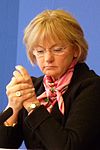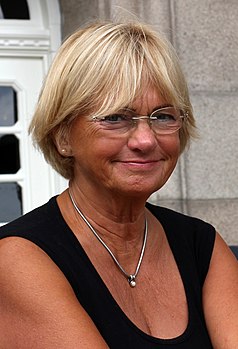
Pia Merete Kjærsgaard is a Danish politician who has been Speaker of the Danish Parliament since 2015.
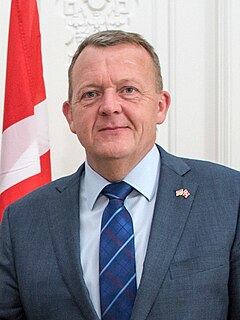
The Prime Minister of Denmark is the head of government in the Kingdom of Denmark. Before the creation of the modern office, Denmark did not initially have a head of government separate from its head of state, namely the Monarch, in whom the executive authority was vested. The Constitution of 1849 established a constitutional monarchy by limiting the powers of the Monarch and creating the office of premierminister. The inaugural holder of the office was Adam Wilhelm Moltke.

The Folketing, also known as the Danish Parliament in English, is the unicameral national parliament (legislature) of Denmark. Established in 1849, until 1953 the Folketing was the lower house of a bicameral parliament, called the Rigsdag; the upper house was Landstinget. It meets in Christiansborg Palace, on the islet of Slotsholmen in central Copenhagen.

General elections were held in Denmark on 20 November 2001. For the first time since the 1924 elections, the Social Democrats did not win the most seats. Anders Fogh Rasmussen of the centre-right Venstre became Prime Minister in coalition with the Conservative People's Party, as the head of the first Rasmussen government, with the support from Danish People's Party.

General elections were held in Denmark on 8 February 2005. Prime Minister Anders Fogh Rasmussen's Venstre retained the largest number of seats in parliament. The governing coalition between the Venstre and the Conservative People's Party remained intact, with the Danish People's Party providing the parliamentary support needed for the minority government. The Danish Social Liberal Party made the biggest gains of any party, although it remains outside the governing group of parties. The election marked the second time in a row that the Social Democrats were not the largest party in the parliament, a change from most of the 20th century. The party lost 5 seats and leader Mogens Lykketoft resigned immediately after the election.
The Danish referendum on the Treaty establishing a Constitution for Europe was a planned referendum to be held on 27 September 2005, that would have put the proposed Constitution to the voters of Denmark for ratification. However, after voters voted down the Constitution in both the French and Dutch referendums before the Danish vote could take place, Danish prime minister Anders Fogh Rasmussen indicated that the referendum would be cancelled. On April 24, 2008 the Danish parliament ratified the Treaty's successor, the Treaty of Lisbon without a referendum.
Ministry for Refugees, Immigrants and Integration of Denmark was a Danish ministerial office, often abbreviated as "Ministry for Integration". The office was created by Prime Minister Anders Fogh Rasmussen on 27 November 2001 when he formed the Cabinet of Anders Fogh Rasmussen I after the 2001 Danish parliamentary election, in which refugees, immigration, and integration of people from non-western countries had been important issues.
Karen Moustgaard Jespersen is a Danish journalist and politician representing the party Venstre.
The Liberal Alliance is a liberal, right-libertarian political party in Denmark.
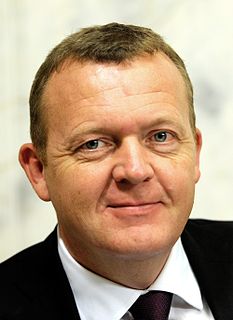
General elections were held in Denmark on 15 September 2011 to elect the 179 members of the Folketing. Of those 179, 175 members were elected in Denmark, two in the Faroe Islands and two in Greenland.
Denmark holds opt-outs from European Union policies in relation to security and defence, citizenship, police and justice, and the adoption of the euro. They were secured under the Edinburgh Agreement in 1992 after a referendum for the ratification of the Maastricht Treaty was rejected by Danish voters, as a package of measure to assuage concerns raised during that referendum.
A referendum on changing the Danish Act of Succession, the rules governing the succession to the Danish throne, was held in Denmark, the Faroe Islands, and Greenland on 7 June 2009, simultaneously with the election to the European Parliament, in Denmark proper.

Lars Løkke Rasmussen is a Danish politician serving as the 25th and current Prime Minister of Denmark since 2015, previously holding the position from 2009 to 2011, and as Leader of the centre-right liberal Venstre party since 2009.
The cabinet of Danish Prime Minister Lars Løkke Rasmussen, was announced on 5 April 2009 as Lars Løkke became prime minister after Anders Fogh Rasmussen was offered the post of Secretary General of NATO on 4 April 2009.

General elections were held in the Kingdom of Denmark on 18 June 2015 to elect the 179 members of the Folketing. 175 members were elected in the Denmark proper, two in the Faroe Islands and two in Greenland. Although the ruling Social Democrats remained the largest party in the Folketing and increased the number of seats they held, the opposition Venstre party was able to form a minority government headed by Lars Løkke Rasmussen with the support of the Danish People's Party, the Liberal Alliance and the Conservative People's Party.
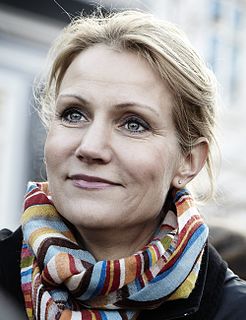
The cabinet of Prime Minister Helle Thorning-Schmidt was the cabinet government of Denmark from 3 October 2011 to 3 February 2014. It was a coalition between the Social Democrats, the Danish Social Liberal Party and the Socialist People's Party. On 9 August 2013, Helle Thorning-Schmidt made a cabinet reshuffle and on 12 December 2013, she made a second cabinet reshuffle. The cabinet resigned on 3 February 2014, following the Socialist People's Party left the government on 30 January 2014. It was succeeded by the Cabinet of Helle Thorning-Schmidt II





